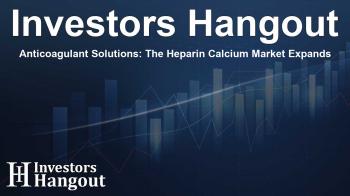Anticoagulant Solutions: The Heparin Calcium Market Expands

Heparin Calcium Market Overview
The heparin calcium market is experiencing remarkable growth, with an expected valuation of nearly 2 billion USD by the end of the next decade. This increase signifies a projected CAGR of approximately 3.4% from now until 2032. The continual escalation in demand for effective anticoagulants reflects the ongoing advancements in this crucial pharmaceutical sector.
Understanding Heparin Calcium
Heparin calcium has become a vital anticoagulant widely utilized to prevent and treat thromboembolic disorders. This medication targets various segments of the clotting cascade to effectively inhibit clot formation. Ongoing research and clinical trials have emphasized enhancing the efficacy and safety profile of heparin calcium, thereby ensuring its critical role in modern medicine.
How Heparin Works
At its core, heparin calcium operates by hindering significant components involved in blood coagulation. By boosting the activity of antithrombin III, this drug plays a vital role in halting the action of thrombin and factor Xa. This mechanism effectively blocks the conversion of fibrinogen to fibrin, which is essential for stable blood clot formation, thus reducing the risk of serious vascular complications.
Market Dynamics and Drivers
Several key factors are driving growth within the heparin calcium market:
Increase in Cardiovascular Diseases
The global prevalence of cardiovascular diseases has risen dramatically, leading to heightened demand for effective anticoagulants like heparin calcium. Given that cardiovascular complications account for a substantial percentage of global mortality, ensuring availability of reliable therapeutic solutions remains paramount in healthcare.
Rise of Subcutaneous Formulations
There is a discernible shift towards subcutaneous formulations of heparin calcium in the market. Traditionally administered intravenously, subcutaneous injections are gaining traction for their ease of use and lower necessity for hospital visits, particularly within home care settings. This trend is particularly beneficial for elderly patients and those requiring long-term anticoagulation therapy.
Emergence of Biosimilars
The development and launch of biosimilars are crucial growth factors in the heparin calcium market. As patents for key heparin products expire, pharmaceutical companies are keen on producing these biosimilar medications to offer cost-effective alternatives.
Geographical Analysis of the Market
Geographically, North America currently holds the largest share of the heparin calcium market, thanks to its advanced healthcare systems and a high incidence of cardiovascular diseases. This region will likely maintain its position as a leader in the market due to continuous innovations and expansive access to anticoagulant therapies.
European Market Growth
Europe is anticipated to exhibit a significant growth trajectory in the coming years. Countries such as Germany, France, and the UK are at the forefront, driven by aging populations and increased focus on managing cardiovascular health issues. The region's access to advanced healthcare frameworks fosters an environment conducive to the widespread adoption of anticoagulant therapies.
Key Players and Innovations
Across the heparin calcium market, several key players are diligently working to expand their footprint:
Notable companies include Sandoz, Fresenius Kabi, and Pfizer. These organizations are increasingly investing in research and development while pursuing strategic partnerships to enhance their product offerings and capture a larger market share.
Recent Developments
In recent months, major industry developments highlight the ongoing progress within the sector. For instance, Pfizer has forged a strategic alliance aimed at enhancing the production of biosimilars within the anticoagulant space, showcasing a commitment to innovation and market expansion. Meanwhile, another key player has ramped up manufacturing capabilities to meet the surging demand for important pharmaceutical products, further indicating the dynamic nature of the heparin calcium market.
Frequently Asked Questions
What is the current valuation of the heparin calcium market?
The heparin calcium market is projected to reach approximately 2 billion USD by 2032, with a CAGR of 3.4% from 2024 to 2032.
How does heparin calcium function as an anticoagulant?
Heparin calcium works by enhancing the activity of antithrombin III, effectively inhibiting thrombin and factor Xa, which are key players in the blood coagulation process.
What are the primary factors driving the growth of the heparin calcium market?
Key growth drivers include the rising incidence of cardiovascular diseases, a shift towards subcutaneous administration, and the emergence of biosimilars.
Which regions are expected to lead in the growing heparin calcium market?
North America currently leads the market, but Europe is anticipated to exhibit significant growth due to aging populations and advancements in healthcare.
Who are some of the notable players in the heparin calcium market?
Key players include Pfizer, Sandoz, Fresenius Kabi, and Baxter International, among others, all of whom are focused on innovation and market competition.
About Investors Hangout
Investors Hangout is a leading online stock forum for financial discussion and learning, offering a wide range of free tools and resources. It draws in traders of all levels, who exchange market knowledge, investigate trading tactics, and keep an eye on industry developments in real time. Featuring financial articles, stock message boards, quotes, charts, company profiles, and live news updates. Through cooperative learning and a wealth of informational resources, it helps users from novices creating their first portfolios to experts honing their techniques. Join Investors Hangout today: https://investorshangout.com/
Disclaimer: The content of this article is solely for general informational purposes only; it does not represent legal, financial, or investment advice. Investors Hangout does not offer financial advice; the author is not a licensed financial advisor. Consult a qualified advisor before making any financial or investment decisions based on this article. The author's interpretation of publicly available data shapes the opinions presented here; as a result, they should not be taken as advice to purchase, sell, or hold any securities mentioned or any other investments. The author does not guarantee the accuracy, completeness, or timeliness of any material, providing it "as is." Information and market conditions may change; past performance is not indicative of future outcomes. If any of the material offered here is inaccurate, please contact us for corrections.
